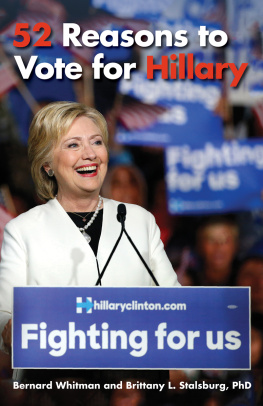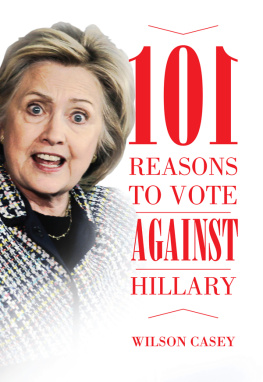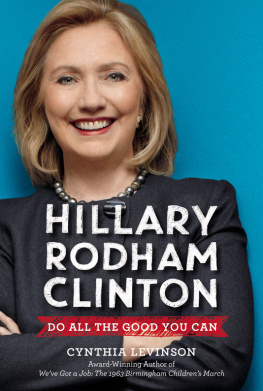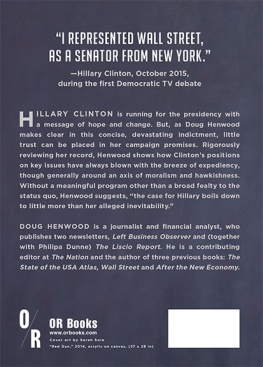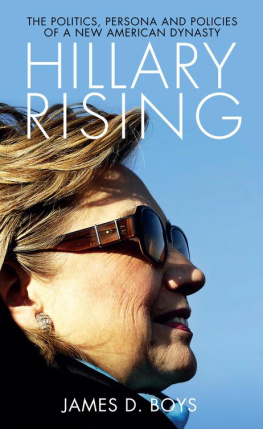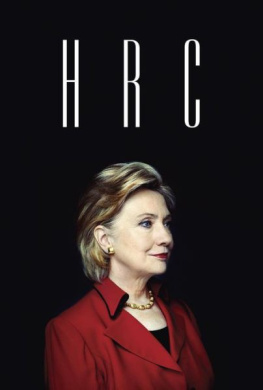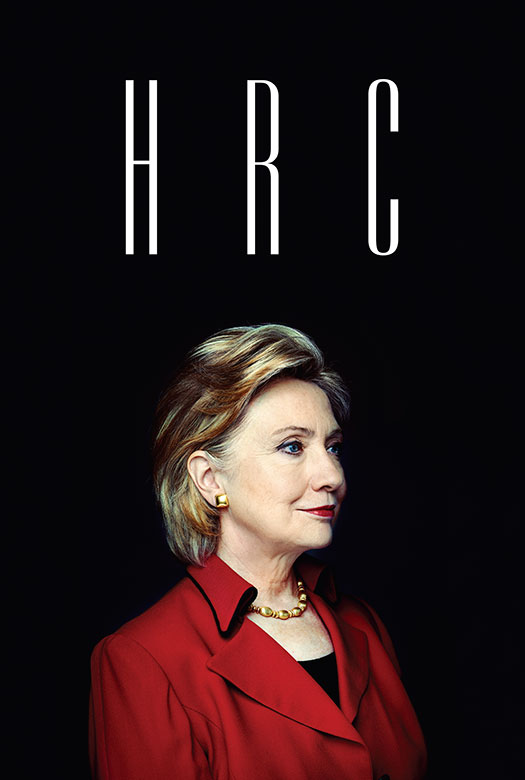Copyright 2014 by Jonathan Allen and Amie Parnes
All rights reserved.
Published in the United States by Crown Publishers, an imprint of the Crown Publishing Group, a division of Random House LLC, a Penguin Random House Company, New York.
www.crownpublishing.com
CROWN and the Crown colophon are registered trademarks of Random House LLC.
Library of Congress Cataloging-in-Publication Data
Allen, Jonathan (Jonathan J. M.)
HRC: state secrets and the rebirth of Hillary Clinton/Jonathan
Allen, Amie Parnes.First edition.
pages cm
1. Clinton, Hillary Rodham. 2. Women presidential candidatesUnited StatesBiography. 3. Presidential candidatesUnited StatesBiography. 4. Women cabinet officersUnited StatesBiography. 5. Cabinet officersUnited StatesBiography. 6. United StatesPolitics and government2009 7. United StatesForeign relations2009 I. Parnes, Amie. II. Title.
E887.C55A49 2013
327.730092dc23
[B] 2013037029
ISBN 978-0-8041-3675-4
Ebook ISBN 978-0-8041-3676-1
Jacket design: Christopher Brand
Jacket photograph: Marco Grob/Trunk Archive
v3.1_r1
As with everything, this is for Stephanie, Asher, and Emma Allen.
J.A.
For Esther and Sherry Parnes, the most inspiring women I know.
A.P.
C ONTENTS
Introduction
Hillary stared at the screen, eyes wide open.
The American consulate before her stood at the edge of civilization, in one of the most lawless places on the planet, amid an epic struggle between moderates and extremists. The diplomats inside believed they were there to help; the anti-American terrorists at the gate most certainly did not.
Frame by frame, in a video-equipped conference room on the seventh floor of the State Departments Washington headquarters, Hillary watched terrorists attacking the outpost. The stultifying images had been captured from a security camera at the American compound. Hillary wanted her top aidesabout two dozen of them had gathered in the conference room with herto get a sense of what people were facing inside these posts, as one of them later put it.
The screening was held shortly after the April 5, 2010, assault, two and a half years before Ambassador Chris Stevens would be killed at the U.S. special mission compound in Benghazi.
Attackers had nearly made it inside the American compound in Peshawar, the gateway to the tribal region of Pakistan that had become the worlds most notorious haven for terrorists. They detonated a truck bomb when it hit a barrier fifty feet from the consulates entrance, and they launched a second-phase assault with guns and grenades. Pakistani employees of the consulate were killed in the attack, but the terrorists were repelled before they could breach the compound. Though in a similarly dangerous region, the Peshawar compound was more fortified than the one at Benghazi because of its status as a consulate, a step below an embassy but still a more permanent installation than the special mission in Benghazi, which is often referred to as a consulate.
The slide show was intended as a wake-up call for the State Department brass. In Peshawar, the attack had been thwarted in large part by a pop-up vehicle barrier and the quick reaction of Pakistani soldiers, who provided host-nation support to the consulate.
Increasingly, the drumbeat of threats against American diplomatic facilities could be heard not just in Iraq and Afghanistan, where the United States had military forces on the ground, but in other places that werent live combat zones. Diplomats were having a harder time doing the basic function of their jobsinteracting with the localswithout the menacing accompaniment of heavily armed convoys and rigorous security precautions.
When Hillary had taken over as secretary, she had spoken at length to Ryan Crocker, the veteran ambassador to Pakistan, Afghanistan, and Iraq, who told her that, despite the dangers, diplomats werent effective if they were constantly hunkered down in heavily barricaded embassies and consulates. She knew that Peshawar was one of the most precariously situated American posts in the world, amid Al Qaeda, Taliban, and other jihadist forces. There were constant threats to the diplomats who ventured into the surrounding community, but this was an attack on their home base.
When Hillary heard about the incident, and the success in holding off the terrorists, she asked Pat Kennedy, the undersecretary who oversaw diplomatic security operations, to brief her team. I want to see it, she had told Kennedy.
Thank God we had the pop-up barriers, she thought, when she watched the images. Whenever there was an attack on an American diplomat or facility, a chorus of voices would argue for pulling back from the site. But Hillary believed that the United States couldnt afford to leave vacuums in troublesome regions. American embassies and consulates, and the diplomats who worked in them, were important tools through which the United States could influence the rest of the world. They were also platforms for intelligence, military, and commercial activity.
Yet the perils of modern diplomacy were clear. American diplomats in war zones were at just as much risk of coming under fire as the military. The difference was that diplomats didnt carry machine guns. Hillary understood that engaging in diplomacy in hostile parts of the world was a calculated risk. She had made the case, within the administration and on Capitol Hill, that funding for the security of diplomatic posts in war zones should be as sacrosanct as the money spent on arming and equipping troops. She had included Pakistan on a list, with Afghanistan and Iraq, of countries where embassy security budgets should be protected by law.
The decision to take time out from one of her tightly run meetings for an embassy security briefing sent a message to the people in the room that Hillary believed at that moment that this is the most important thing for us to be talking about, said another source who was present.
It wouldnt be the last time.
Near the end of her tenure at State in September 2012, the Benghazi attackessentially the three a.m. call she had campaigned on in 2008interrupted the smooth narrative arc of Hillarys political comeback. For four years, from the day she accepted Barack Obamas invitation to join his cabinet, Hillary had been engaged in a peripatetic rebuilding and rebranding campaign. All at once, and with disciplined follow-through, she had enhanced the State Department, Americas relationships with some foreign countries, and her own brand at home. The mission required a survivors strength, a gatherers cultivation of political capital, a hawks vigilance, and the ambition of a woman who believes she should be president. Taking the job had been a risk, just as continuing to engage in diplomacy in dangerous parts of the world was a risk.
Hillary explained, both before the Benghazi attack and after it, her view that the United States couldnt simply pull back from the most precarious parts of the world because of the danger to diplomats. Instead of avoiding risk, she argued, it was the job of the State Department to mitigate and manage it, a point of view that reflects her own personal calculations about risk and reward.
Hillary also harbors a related trait that one source calls a bias for action, which influences her decision-making process. It can be seen in her approach to going after Osama bin Laden, in her building of a coalition to intervene militarily in Libya, and even in the way she encourages her aides to innovate and improvise, whether in building partnerships, aiding rebels, or, in the case of Richard Holbrooke, searching unsuccessfully for the right recipe for peace in Afghanistan.


